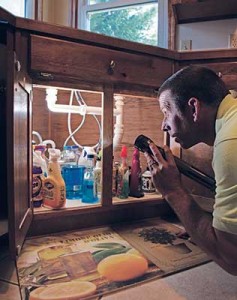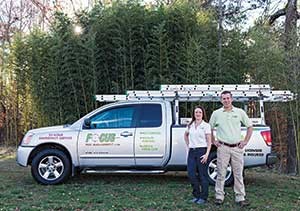
For Kauffmann, ant management all goes back to inspection and being environmentally conscious.
Photo: Matthew Druin & Co.
For 25 years, John Kauffmann worked for large and small pest management companies in Florida and Georgia. He gained experience controlling pests that infested residential and commercial structures and lawns and shrubs, as well as controlling wildlife in various areas.
He eventually moved to Woodstock, Ga., to be closer to relatives. And in 2011, he used his professional experience to his advantage by starting his own company. Focus Pest Management, a member of Angie’s List, concentrates on household pests, wildlife removal, lawn and shrub care and leafproof gutter protection. Kauffmann uses botanical and organic insecticides in various pest control programs.
Company image is important to Kauffmann, who doesn’t want to be perceived as a killer or an exterminator.
“A cleaner, greener image means a lot to customers, so it’s important to have clean trucks and a clean image,” he says.
Focus is a small company — Kauffmann is the sole owner and operator.
“I do all the pest-related work,” he says, adding that his wife, Paige Soldo Kauffmann, handles scheduling and administrative work, and accompanies Kauffmann on ridealongs to learn more about the industry.
Learning the ropes
Kauffmann started his career as a lawn technician in Orlando, Fla., with Middleton Lawn & Pest Control. He transitioned to a pest management technician, managing general pests and termites, inside and outside of structures. Then he went to work for Pestban Pest Control.
“That was a great company to work for,” Kauffmann says, acknowledging he worked in many different areas of the business, including lawn care and pretreats.
Kauffmann’s next move was to a landscape company as a horticulture specialist, treating sports fields and commercial properties. He then moved to Critter Control, where he trapped and excluded wildlife.

Kauffmann’s wife, Paige Soldo Kauffman, handles all scheduling and administrative work. Photo: Matthew Druin & Co.
“That was a totally different feel of pest management,” he says. “At the time, in the late ’90s, very few pest management professionals were controlling wildlife.”
Kauffmann’s experience makes him well rounded. He has three pest management-related licenses in Georgia and Florida: a structural pest control license, a nuisance wildlife license, and a turf-and-ornamental (T&O) license. The wildlife license is renewed every year, while the T&O license is renewed every five years with 10 required continuous hours of education. The Georgia structural license requires 25 hours of continuing education for five years and the Florida license requires four hours yearly.
“Companies have a tendency to get too big and spread out, which makes it more difficult to train employees properly — and customers feel that,” he says. “Companies also tend to pressure technicians to finish as many jobs as possible because it’s all a numbers game. You’re supposed to take your time to do a thorough inspection to find causes of an infestation. It’s not about doing service quickly. You need to do a thorough inspection to eliminate callbacks, because callbacks cost time and money.”
Continuing education is one of Kauffmann’s success strategies. He says it’s important to keep up with the newest technology and insects that have appeared within the past decade, such as the Argentine ant (Linepithema humile).
Ants marching
In North Georgia, Kauffmann controls primarily Argentine ants, and the occasional carpenter ant. Argentine ants come in large numbers and are found in all areas of homes, especially in bedrooms and on windowsills. Regardless of where the ants are, though, inspection is the key.
“If the ants are inside a home, be sure to inspect the adjacent rooms,” he says. “Then you inspect outside to see where they’re coming in.”
Kauffmann prefers to use liquid insecticide to suppress ant pressure. He uses baits outside homes if he has difficulty finding the nests. Baits help increase trailing to make it easier to find where ants are coming from, ultimately leading to the nests.
On one job, Argentine ants were trailing all around a house and in the driveway. They were crawling into windows and cracks of the brick facade. So Kauffmann took an aggressive approach with a liquid insecticide and followed up every five to seven days. His follows-ups enabled him to find the nest, which was outside.
“It was a success because I never had to go inside the home,” he says. “Good follow-ups and inspections led to finding the root of the problem. It took 60 days to eliminate ants from being a problem inside the home.”
When Kauffmann treats inside a home, he uses boric acid dust in cracks and crevices, wall voids and wet areas such as kitchens and bathrooms. Outside, he recommends customers trim shrubs away from the house, clean gutters and avoid stacking wood right next to the house. It’s all part of Kauffmann’s search to eliminate conducive environments. For many of his customers, he only treats inside the home once.
Since Kauffmann started in the business, ant management has improved dramatically.
“We used to mix jelly and boric acid in a 5-gal. bucket, then take straws and inject the mixture on a flash plate,” he says. “That’s basically all we had. The jelly and boric acid were effective with certain ants, but it wasn’t effective on pavement, crazy and pharaoh ants. And baiting took a lot longer to solve the problem. Nowadays, we have good baits by numerous manufacturing companies available to us.”
For Kauffmann, ant management — and for that matter, pest management in general — all goes back to inspection and being environmentally conscious.
“Many problems can be solved from outside the house,” he says. “Training explains ants and their biology, but most textbook training doesn’t provide you the steps to track down ants to find their nesting sites. That’s up to you.”
Kauffmann’s business tips
⦁ Contracts: DO get a signed contract/agreement before performing work. DON’T make contracts/agreements with a lot of small print. It makes the customer leery and skeptical.
⦁ Training: DO make sure your employees are properly trained in company policies, applications and inspections before releasing them on their own. DON’T skip out on continuous training. Important updates to rules and procedures could save your business time, money and, most importantly, someone’s life.
⦁ Equipment: DO provide employees with quality equipment that will last, hopefully, for years and will allow them to work effectively. DON’T neglect to provide the proper safety and protection equipment for employees.
⦁ Customer communication: DO keep your customers in the loop with what’s being done to correct or prevent pest pressure. Explain to the customer what will be done, what has been done and what to expect from treatment. DON’T make promises you can’t keep.
⦁ Marketing: DO your own research about a marketing company before signing on, including contacting some of their clients to hear firsthand about their success or failure. DON’T believe any marketing company that promises first-page Google placement.
⦁ Networking: DO network with as many people as possible, explaining what you can do for them. Networking is another way to brand your company and develop name recognition. DON’T network with competition that provides the exact same services as you or your idea may become “their” idea. Your competition doesn’t need to know what you’re up to.
Kauffmann’s technical tips
⦁ Insecticide: DO always read the label. Choose the right insecticide for the job at hand. DON’T spray for the sake of spraying.
⦁ Baits: DO apply baits when colonies can’t be located or if areas are too sensitive for liquids or dusts. DON’T automatically bait indoors because it’s the easy thing to do. Remember, to bait means to attract. Your customers don’t want to see insects inside their home — that’s why they contacted you in the first place.
⦁ Ant management: DO look for conducive conditions such as too much mulch, woodpiles, tree branches touching the house, etc. DON’T hurry and neglect to inspect during treatment times.
⦁ Equipment: DO take the time daily to inspect, clean and repair equipment. DON’T neglect your equipment. The last thing you need is a leak or, even worse, a catastrophic disaster.
⦁ Inspection: DO realize a thorough inspection can save you time and money. It also can make the customer happy knowing you’re observant and mindful. DON’T treat every job like they’re the same. Each job has its own uniqueness when thoroughly inspected.
⦁ Saving time: DO conduct a thorough inspection every time. By thoroughly inspecting, you’ll be able to solve the problem at hand instead of scheduling follow-ups and callbacks. Follow-ups and callbacks cost money, and take away from the time you could use to service a potential customer. DON’T get into the mindset of “just get it done.” Rushing through jobs will cost more in callbacks and, even worse, a canceled customer.
Contact John Walsh at jwalsheditor@gmail.com.
Leave A Comment